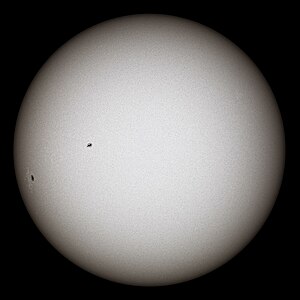Tadau
Kokitanan
 The Sun, filmed through a clear solar filter | |
| Names | Tadau, Sol,[1] Sól, Helios[2] |
|---|---|
| Adjectives | Solar[3] |
| Symbol | |
| Observation data | |
| Mean distance from Earth | 1 AU 149,600,000 km 8 min 19 s, light speed[4] |
| −26.74 (V)[5] | |
| 4.83[5] | |
| G2V[6] | |
| Metallicity | Z = 0.0122[7] |
| Angular size | 0.527–0.545°[8] |
| Orbital characteristics | |
Mean distance from Milky Way core | 24,000 to 28,000 light-years[9] |
| Galactic period | 225–250 million years |
| Velocity |
|
| Obliquity |
|
Right ascension North pole | 286.13° (286° 7′ 48″)[5] |
Declination of North pole | +63.87° (63° 52′ 12"N)[5] |
Sidereal rotation period |
|
Equatorial rotation velocity | 1.997 km/s[11] |
| Physical characteristics | |
Equatorial radius | 6.957 x 108 m[12] 109 × Earth radii[11] |
| Flattening | 0.00005[5] |
| Surface area | 6.09×1012 km2 12,000 × Earth[11] |
| Volume |
|
| Mass | |
| Average density | 1.408 g/cm3 0.255 × Earth[5][11] |
| Age | 4.6 billion years[13][14] |
Equatorial surface gravity | 274 m/s2[5] 27.9 g0[11] |
| ≈0.070[5] | |
Surface escape velocity | 617.7 km/s 55 × Earth[11] |
| Temperature |
|
| Luminosity | |
| Color (B-V) | 0.656[15] |
| Mean radiance | 2.009×107 W·m−2·sr−1 |
Photosphere composition by mass | |
Tadau (simbol ![]() ) ko id Boros Malayu nopo nga ointutunan do Matahari, nopo nga iso rombituon di tosomok kopio miampai do Bumi i kisinodu do purata 149 680 000 kilometer (93,026,724 watu). Tadau om walu planet ii mombontuk Sistom Suria.
) ko id Boros Malayu nopo nga ointutunan do Matahari, nopo nga iso rombituon di tosomok kopio miampai do Bumi i kisinodu do purata 149 680 000 kilometer (93,026,724 watu). Tadau om walu planet ii mombontuk Sistom Suria.
Sukuon
[simbanai | simbanai toud]- ↑ Ralat maganu:Tag
<ref>tidak sah; tiada teks disediakan bagi rujukan yang bernamaOED - ↑ Ralat maganu:Tag
<ref>tidak sah; tiada teks disediakan bagi rujukan yang bernamaLexico - ↑ Ralat maganu:Tag
<ref>tidak sah; tiada teks disediakan bagi rujukan yang bernamaOED2 - ↑ Pitjeva, E. V.; Standish, E. M. (2009). "Proposals for the masses of the three largest asteroids, the Moon–Earth mass ratio and the Astronomical Unit". Celestial Mechanics and Dynamical Astronomy (id boros Inggilis). 103 (4): 365–372. Bibcode:2009CeMDA.103..365P. doi:10.1007/s10569-009-9203-8. ISSN 1572-9478. S2CID 121374703. Pinoopi mantad sanḏad ontok 9 July 2019. Linoyog ontok 13 July 2019.
- ↑ 5.00 5.01 5.02 5.03 5.04 5.05 5.06 5.07 5.08 5.09 5.10 5.11 5.12 5.13 Williams, D. R. (1 July 2013). "Sun Fact Sheet". NASA Goddard Space Flight Center. Pinoopi mantad sanḏad ontok 15 July 2010. Linoyog ontok 12 August 2013.
- ↑ Zombeck, Martin V. (1990). Handbook of Space Astronomy and Astrophysics 2nd edition. Cambridge University Press. Pinoopi mantad sanḏad ontok 3 February 2021. Linoyog ontok 13 January 2016.
- ↑ Asplund, M.; Grevesse, N.; Sauval, A. J. (2006). "The new solar abundances – Part I: the observations". Communications in Asteroseismology. 147: 76–79. Bibcode:2006CoAst.147...76A. doi:10.1553/cia147s76. ISSN 1021-2043. S2CID 123824232.
- ↑ "Eclipse 99: Frequently Asked Questions". NASA. Pinoopi mantad sand̠ad ontok 27 May 2010. Linoyog ontok 24 October 2010.
- ↑ Francis, Charles; Anderson, Erik (June 2014). "Two estimates of the distance to the Galactic Centre". Monthly Notices of the Royal Astronomical Society. 441 (2): 1105–1114. arXiv:1309.2629. Bibcode:2014MNRAS.441.1105F. doi:10.1093/mnras/stu631. S2CID 119235554.
- ↑ Hinshaw, G.; Weiland, J. L.; Hill, R. S.; Odegard, N.; Larson, D.; et al. (2009). "Five-year Wilkinson Microwave Anisotropy Probe observations: data processing, sky maps, and basic results". The Astrophysical Journal Supplement Series. 180 (2): 225–245. arXiv:0803.0732. Bibcode:2009ApJS..180..225H. doi:10.1088/0067-0049/180/2/225. S2CID 3629998.
- ↑ 11.0 11.1 11.2 11.3 11.4 11.5 "Solar System Exploration: Planets: Sun: Facts & Figures". NASA. Pinoopi mantad sand̠ad ontok 2 January 2008.
- ↑ 12.0 12.1 Prša, Andrej; Harmanec, Petr; Torres, Guillermo; et al. (2016-08-01). "NOMINAL VALUES FOR SELECTED SOLAR AND PLANETARY QUANTITIES: IAU 2015 RESOLUTION B3 * †". The Astronomical Journal. 152 (2): 41. arXiv:1510.07674. doi:10.3847/0004-6256/152/2/41. ISSN 0004-6256.
- ↑ Bonanno, A.; Schlattl, H.; Paternò, L. (2002). "The age of the Sun and the relativistic corrections in the EOS". Astronomy and Astrophysics. 390 (3): 1115–1118. arXiv:astro-ph/0204331. Bibcode:2002A&A...390.1115B. doi:10.1051/0004-6361:20020749. S2CID 119436299.
- ↑ Connelly, J. N.; Bizzarro, M.; Krot, A. N.; Nordlund, Å.; Wielandt, D.; Ivanova, M. A. (2 November 2012). "The Absolute Chronology and Thermal Processing of Solids in the Solar Protoplanetary Disk". Science. 338 (6107): 651–655. Bibcode:2012Sci...338..651C. doi:10.1126/science.1226919. PMID 23118187. S2CID 21965292.(registration required)
- ↑ Gray, David F. (November 1992). "The Inferred Color Index of the Sun". Publications of the Astronomical Society of the Pacific. 104 (681): 1035–1038. Bibcode:1992PASP..104.1035G. doi:10.1086/133086.
- ↑ "The Sun's Vital Statistics". Stanford Solar Center. Pinoopi mantad sanḏad ontok 14 October 2012. Linoyog ontok 29 July 2008. Citing Eddy, J. (1979). A New Sun: The Solar Results From Skylab. NASA. p. 37. NASA SP-402. Pinoopi mantad sanḏad ontok 30 July 2021. Linoyog ontok 12 July 2017.
Kategori:
- Laman dengan ralat rujukan
- CS1 Inggilis-language sources (en)
- Pages with login required references or sources
- Articles with short description
- Short description is different from Wikidata
- Articles with hatnote templates targeting a nonexistent page
- Missing redirects
- Featured articles
- Wikipedia pages with incorrect protection templates

